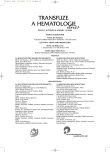Non-invasive prenatal diagnosis from maternal peripheral blood is performed on fractionated extracellular fetal DNA with size < 500 bp
Authors:
I. Hromadníková 1; L. Žejšková 1; J. Doucha 2; D. Wagenknecht 1
Authors‘ workplace:
Laboratoř buněčné biologie, Pediatrická klinika, 2Gynekologicko-porodnická klinika, 2. LF UK a Fakultní nemocnice
Motol, Praha
1
Published in:
Transfuze Hematol. dnes,12, 2006, No. 2, p. 95-99.
Category:
Comprehensive Reports, Original Papers, Case Reports
Overview
Apoptotic bodies derived from placental trophoblasts represent the most important source of extracellular fetal nucleic acids (DNA and RNA) for the purpose of non-invasive prenatal diagnosis. In this work we studied the fragmentation of extracellular DNA present in maternal circulation of 6 pregnant women within 16th week of gestation. Extracellular DNA was separated by using agarose gel electrophoresis size-fractionation. Fetal and total circulatory DNA was quantified in individual fractions with an approximate size of 100–300 bp, 300–500 bp, 500–700 bp, 700–900bp, > 900 bp by using real-time PCR, specific primers and TaqMan probes for SRY and GLO genes. Fetal circulatory DNA was mainly detected in section with a size 100–300 bp with the concentration of 14.8 GE/ml (range 1.56–83.2). Lower amount of fetal circulatory DNA, 1.53 GE /ml (range 0–10.8), was also found in a fraction with a size 300–500 bp. No fetal DNA was detected in fractions with an approximate size of 500–700 bp, 700–900 bp and more than 900 bp. Circulatory DNA extracted from the gel fragment with a molecular size less than 300 bp contained 4.8 x (range 0x–16.6x) enriched fetal DNA when compared with initial unseparated DNA sample, which has been usually used to detect fetal paternally inherited alleles. If we focused on isolation of DNA with a size of 100–300 bp, we could get more concentrated but not purified fetal DNA. The median percentage of foetal derived DNA in this fraction was 1.15 % (range 0.16–8.0). However median percentage of fetal derived DNA in unseparated extracellular DNA was 0.29 % (range 0.06–1.78). Our experience revealed that the usage of enriched size-fractionated fetal DNA is not suitable for routine clinical applications.
Key words:
apoptosis, extracellular fetal DNA, fragmentation, real-time PCR, maternal plasma, SRY gene, GLO gene, trophoblast
Labels
Haematology Internal medicine Clinical oncologyArticle was published in
Transfusion and Haematology Today

2006 Issue 2
Most read in this issue
- Chronic idiopathic myelofibrosis: biological characterization and histological “grading” of the fibrosis with respect to diagnosis and prognosis
- Anagrelide in the treatment of thrombocytosis in myeloproliferative disease – case report
- Hemorrhagic complications during warfarin therapy
- Idiopathic thrombocytopenic purpura in pregnancy refractory to immunosuppressive treatment – case report
